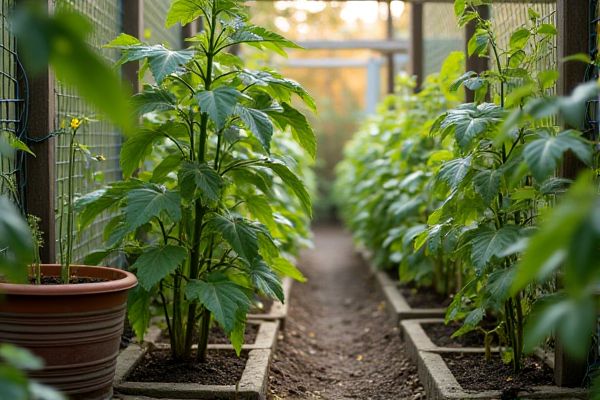
A bean trellis provides strong vertical support ideal for climbing beans, promoting better air circulation and easier harvesting compared to the typically round and shorter tomato cage designed to contain sprawling tomato plants. Discover which option best suits your garden needs by reading the rest of the article.
Table of Comparison
| Feature | Bean Trellis | Tomato Cage |
|---|---|---|
| Purpose | Supports climbing beans and pole crops | Supports growing tomato plants |
| Structure | Flat or A-frame vertical framework | Cylindrical, cage-like frame |
| Material | Wood, bamboo, metal, or plastic | Metal wire or sturdy plastic |
| Stability | Requires securing to ground or wall | Self-supporting, placed around the plant |
| Plant Growth Support | Allows vertical climbing and air circulation | Provides lateral support to prevent branch breakage |
| Common Uses | Pole beans, peas, cucumbers | Tomatoes, peppers, eggplants |
| Ease of Installation | Needs assembly and secure anchoring | Easy placement around plant base |
| Cost | Typically low to moderate | Moderate to high depending on size/material |
Introduction to Bean Trellis and Tomato Cage
A bean trellis is a vertical support structure made from wood, metal, or plastic designed to guide climbing bean plants and optimize space in gardens. A tomato cage, typically cylindrical and made of wire, provides sturdy support for bushy tomato plants, preventing sprawling and fruit damage. Both tools enhance plant growth but cater to the distinct climbing habits of beans and the upright growth of tomatoes.
Key Differences Between Bean Trellis and Tomato Cage
Bean trellises typically consist of vertical or angled structures designed to support climbing beans, promoting airflow and easy harvesting. Tomato cages are usually cylindrical wire frameworks that contain the bushy growth of tomato plants, preventing sprawling and fruit damage. Your choice depends on the plant's growth habit and space, with trellises offering more height for vine crops and cages providing lateral support for tomatoes.
Pros and Cons of Bean Trellis
A bean trellis offers superior vertical growth support, maximizing garden space and enhancing air circulation, which reduces the risk of fungal diseases. However, it requires more setup time and materials compared to a tomato cage and can be less stable in high winds. Despite this, the increased yield and ease of harvesting beans make the trellis a preferred choice for many gardeners.
Pros and Cons of Tomato Cage
Tomato cages provide sturdy vertical support, allowing tomato plants to grow upright and improving air circulation, which helps reduce the risk of fungal diseases. However, they can be bulky and difficult to store, and may not accommodate plants with heavy fruit or extensive branching as effectively as custom trellises. Your choice depends on garden space and plant type, as tomato cages offer convenience but might limit growth flexibility compared to bean trellises.
Best Vegetables for Bean Trellis
Pole beans and cucumbers are the best vegetables for a bean trellis due to their climbing growth habit. Peas also thrive when supported by a bean trellis, maximizing vertical space and improving air circulation. Unlike tomato cages, which are designed for bushy plants like tomatoes, bean trellises provide optimal support for vining crops to climb efficiently.
Ideal Plants for Tomato Cage
Tomato cages are ideal for supporting indeterminate tomato varieties that grow tall and require sturdy structures to prevent sprawling and breakage. These cages provide vertical support, allowing the plant to grow upward and improving air circulation around the foliage, which helps reduce the risk of fungal diseases. Unlike bean trellises that are better suited for vining beans, tomato cages accommodate the heavy fruit load and sprawling growth habit of tomatoes effectively.
Cost Comparison: Bean Trellis vs Tomato Cage
Bean trellises typically cost less than tomato cages due to their simpler design and use of basic materials like bamboo or wood, whereas tomato cages are often made from metal and can be more expensive. The price of a basic bean trellis ranges from $5 to $15, while tomato cages generally cost between $10 and $30 depending on size and durability. For gardeners seeking budget-friendly options, bean trellises offer a cost-effective solution without compromising support for climbing plants.
Installation Tips for Both Supports
When installing bean trellises, secure the frame firmly into the ground using sturdy stakes and ensure the netting or wires are taut to support vigorous climbing roots. Tomato cages should be placed around young plants early, pushed deep into the soil for stability, and adjusted as the plant grows to prevent damage and maintain support. Your choice between a bean trellis or tomato cage depends on ease of installation and the specific growth habits of your plants, with both requiring regular checks for stability throughout the growing season.
Maintenance and Durability Considerations
Bean trellises often require more regular maintenance than tomato cages due to their taller, more intricate structures which may need periodic tightening and alignment to support vigorous vine growth. Tomato cages, typically constructed from sturdy galvanized steel, offer greater durability and require minimal upkeep, making them a low-maintenance option for season-long support. The material quality and weather resistance of both supports influence their lifespan, with coated metal cages generally outperforming wooden or plastic trellises prone to rot or breakage.
Which Support is Right for Your Garden?
Bean trellises offer vertical growth support ideal for pole beans, maximizing space and increasing air circulation to reduce disease risk. Tomato cages provide sturdy, multi-level enclosure supporting heavy fruit and sprawling stems, best suited for indeterminate tomato varieties. Selecting the right support depends on plant type, garden space, and desired maintenance ease--bean trellises work well for climbing vines, while tomato cages stabilize bushier, fruit-laden plants.
 homyna.com
homyna.com